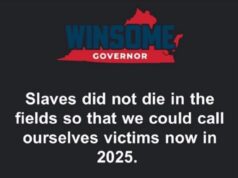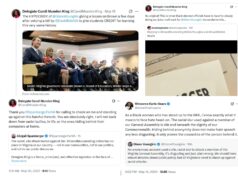by Fairfax County School Board member Karen Keys-Gamarra
In the past few weeks, many people, especially African Americans, have had to reconcile what they have seen in witnessing the murder of George Floyd and that of their own experience. I am no exception.
I have lived long enough to wipe away many tears of frustration in moments that simply did not recognize or appreciate our humanity. Whether it was in my new elementary school, where I became the first black girl in the class, and the teachers stood behind me in amazement because they did not expect me to exhibit logical thought. Or, as a mother who fiercely protected her kids. Or in every workplace I have encountered. The root was always the same: racism.
Racism, or the “R” word, can become a hideous tool that acknowledges a structure kept in place to maintain control and dominance of another. I have seen both the masterful and the novice attempt to use “R” as a weapon to steer the actions of others and/or to demean me, or sometimes both. Whether I was walking my son’s bike home in my neighborhood so that he could stay to have a sleep over; or, conducting a campaign during an election; or, working to protect children; or in the Board rooms’ the truly crafty find this tool handy.
I don’t always speak about it, but I do see it and I respond when I believe the action I am experiencing is so cruel that it resembles that of an overseer who demands compliance. I say what I have to and I work in difficult situations because I must. This is not an accusation of every person I have met, but the widespread presence of racism is a stain to this democracy and to the life experience of many in my community. I have been patient and collaborative. I have had hard discussions with folks, some fruitful and some not. Now it is time to simply diagram what a life in a society where racism has not been eradicated really looks like. It is not all inclusive, but a conversation starter. We need to face “R” and we need to take affirmative steps to do something about it.
I, like many others, have grown intolerant of the structures founded on racism—that belief that allows us to treat others differently, to feel superior or to dominate and oppress another with a self-righteous justification. The “R” can be comprised of aggressive or passive aggressive acts, even micro-aggressive acts, as “R” comes in many forms. For some, it is revealed in overt murderous acts – or for the more subtle, manipulative acts that use code words that allude to race without ever having to mention the word. For the truly sophisticated, it shows up in delay tactics, calls for comfort to naysayers, or an attempt to find the right person for the job. Oh, and my favorite, let’s pit blacks in this workspace against one another because after all, we only need one.
My intolerance is a response to a system of actions with a 400-plus year history in this nation. The systems of Racism where installed when a few crafty businessman acted on the belief that human trafficking, and receiving work without compensation to the slave, could be a profitable business. Slavery doesn’t belong to Blacks, as it has been a worldwide practice. While slavery has been abolished in the U.S., its hideous remnants remain. So here you will find a few more characteristics and scenarios that help identify the trappings of this diabolical weapon.
More Details on What “R” Looks like
Racism is always something that is expected to create a structure of power. It is often practiced in secret and sometimes those who witness it become complicit. For some, there is an inherent need to be a part of the powerful and not the powerless. For other witnesses, they can become complicit by being unaware of past practices or a culture. Racism is always a form of bullying, because it is a way to whip another person(s) into submission. Racism can also occur amongst those who genuinely want to do the right thing, but are less familiar with this tactic. It is often masked as a pending question, where there’s an effort to achieve the right “fit” or find the best person for the job. The word racism itself is rarely used in these situations.
When It Appears
I was in first grade when I realized that racism would be a part of the tapestry of my life. I was playing in front of my new house with my brother. A little girl stood at the end of her driveway and just looked at me and my brother. I invited her to join us. Her response was, “my daddy doesn’t allow me to play with people like you.” I kept playing; after all, I was with my brother, she was alone. Later, I learned that she was the daughter of a police officer. My mother, who was masterful in being a strong woman who determined her own path, told me that some people have a problem, but to never let “their problem” become “your problem.” I still live by those words today. She also raised me with what some might call “good home training.” I learned that I would be judged, but not to internalize, that I must keep my composure, to speak enough words to get my point across and to never waste energy on those who create distractions and eat up my time. All actions do not require a reaction but I would learn the difference. But back to that intolerance…
Racism Always Expects a Culture of Tolerance
In my mother’s generation, society expected a “well-behaved Negro.” This term referred to the dignified person who did not crack under pressure. The well-behaved Negro protested with MLK and didn’t fight back; sat at the counter while being spat upon; went to the work place worked hard and was passed over for promotions; and endured code language that demeaned the quality of their work and/or pitted blacks against one another for the same job. After all, we only need one black person to look like its not “R,” right? It is the culture of the “well-behaved Negro” that taught black parents to teach their kids to obey the police, to keep their hands on the wheel, to speak politely—these are all the lessons of the “well-behaved Negro.” Emmett Till was killed because he was accused of violating the silent code of the “well-behaved Negro.”
After the Civil War, the KKK worked across this nation sowing the seeds of fear through threat, lynchings and other forms of violence to enforce the code of the “well-behaved Negro.” This code also tells Black folk to stay in their place or face penalty that most times was not addressed by law enforcement. In 1921, we saw the burning of “Black Wall Street” in Tulsa, Oklahoma – part of a trend in several cities where countless murders occurred because those folks violated the code. Implicitly, the code require submission of Black folk to the dominant race and in police encounters today, it says that your life can end in a millisecond. Amy Cooper of Central Park relied upon the code when she called the police and falsely accused a black man of threatening her. What made her disregard the fact that she was being filmed? Yes, “R” causes blindness, too because Amy relied upon and expected the police to enforce the code of the “well-behaved Negro.” While poor Amy read law enforcement right, as she has faced no legal ramifications for her act, she underestimated the social tolerance for her demand – and so her name will forever be used as an example of a woman who expected privilege and used racism to achieve her goal.
What this Intolerance means.
With the demonstrations of protest all around us, the message is clear: We will not be your “well-behaved Negro.” Whether it’s law enforcement or the Board room, the time for sucking it up and watching the effects of “R,” even if it is quietly implemented to achieve a desired goal — those times are over. I have felt this indignation in me. I have seen it in my friends, whether black, white, Hispanic or other races or creeds. The folks we see in the streets are not just the recipients of these heinous acts but those who have grown intolerant of them as well.
This intolerance also means that we must take affirmative steps to eradicate the effects of “R” in every level of our lives.
What we must Understand
- That racism and the remnants of it have survived for more than 400 years in this country, because it has been accepted and the majority has been silent.
- We must recognize that these “R” practices – whether overt, subtle or existing in the form of whispers disparaging the work of another who isn’t even aware of the conversation – exist and thrive in the dark of private conversations where they are less likely to be detected or judged by a collective body.
- Racism is always about power. Those who use its tools have an objective that allows that person to have the upper hand.
- Racism always leaves someone or some group of people on the outside of the conversation where future control is being determined.
- One of the most difficult forms of “R” is often found in the political arena, pitting one person against the other, isolating people of the same race from one another. This may appear between political parties or within the same (think Trump and his Black spokespersons).
What we must Do
- Recognize that an intolerance of racist and oppressive tactics is a bullying tactic. Being silent is a complicit act that harms another human being.
- Know that this growing intolerance for racism includes an intolerance for the fake, presumed, self-proclaimed “wokeness” that is in actuality, a form of sleep walking.
- Presume that we do not understand and work to gain understanding.
- Recognize that a failure to act now is a continuing injury to the recipients of both overt and subtle acts that oppress a people that deserve respect and a recognition of their value.
- Ask questions at the library not of your black friends. While some black folk, myself included, do not mind discussing this issue, it is not my responsibility to educate those who may need further enlightenment.
- Speak up when those private conversations take place that devalue a person of color and dig to get at the source of reason for the discussion. Ask the question, what does the person who whispers have to gain from that conversation?
- Speak up when the telling of history does not recognize the value of all involved.
- Talk to your friends and work to learn together.
- Remember that the burden of racism and what it has created belongs to all and we must all work to eradicate it.
- Understand that “R” has impacted every area of American life, from the church, to the schools, to the courts, to the board room.
- Don’t give up. Just because this is the way it has been, that fact doesn’t determine our future.
Conclusion
I want my friends to know that I appreciate all the cards, notes and words of assurance. I know that we have many allies and people who want to do the right thing. But the desire to do the right thing isn’t enough. We must collectively meet wherever we are and ask, what can I do? How can I learn and how can I assist in implementation of better procedures and policies? How can I listen better today? How can we weed out code words in conversation and make sure that we are never complicit in the divisions that racism creates. This is our burden, this is our work. Let’s tear these barriers down, together!


 Sign up for the Blue Virginia breaking news newsletter
Sign up for the Blue Virginia breaking news newsletter











